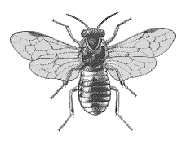Symphyta
|
|
| Sawflies | ||||||||||
|---|---|---|---|---|---|---|---|---|---|---|
 Adult female sawfly | ||||||||||
| Scientific classification | ||||||||||
| ||||||||||
| Families | ||||||||||
|
(Cephoidea) |
Symphyta is a group of insects, a taxonomic suborder of the Hymenoptera. The Symphyta are commonly referred to as sawflies, and include insects belonging to several families. They are considered to be the most primitive Hymenoptera and are closely related to wasps, bees and ants, those being members of the suborder Apocrita.
Sawflies are distinguishable from most other Hymenoptera by the broad connection between the abdomen and the thorax (see image). The common name comes from the appearance of the ovipositor, which looks much like the blade of a saw. This ovipositor, which is modified into a stinger in members of the Apocrita, is not used as a weapon. Females use the ovipositor to cut into plants where they lay their eggs. A few species have long thin ovipositors used to drill holes deep into wood.
The larvae look like caterpillars (the larvae of moths and butterflies). Adult sawflies, except for those in the family Cephidae, have structures on the underside of the forewings that help hold the wings in place when the insect is at rest. These cenchri, which are absent in member of the suborder Apocrita, are located behind the scutellum on the thorax.
Sawfly larvae are herbivorous, the group feeding on a wide range of plants. Individual species, however, are quite specific in their choice of plants used for food. The larvae of various species exhibit leaf-mining, leaf rolling or gall formation. Large populations can cause economic damage in cultivated areas and forests. Adults are carnivorous, eating other insects, but many also feed on nectar.
